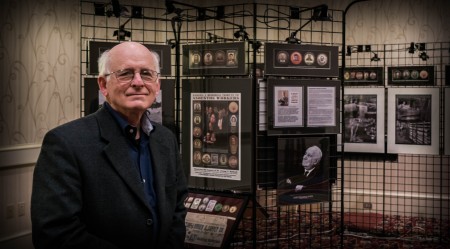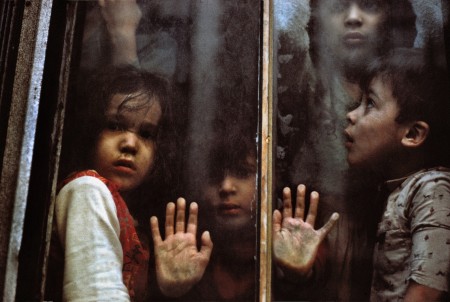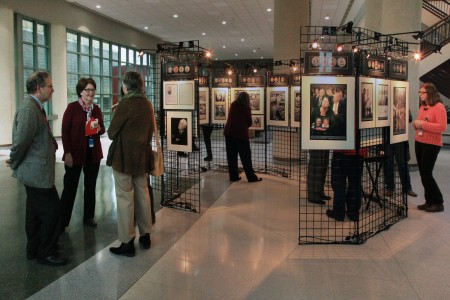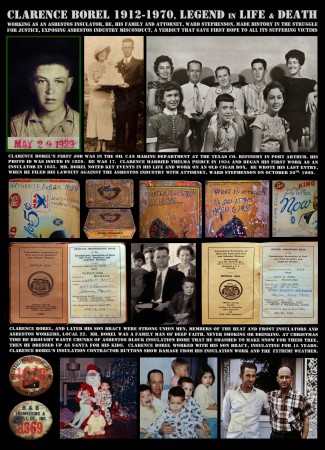Posted on April 26, 2016
This week I had the pleasure of interviewing Earl Dotter, who for nearly fifty years has focused on photographing hazardous occupations in the USA beginning with coal miners in 1969, then the most dangerous job in America. Earl Dotter has been a relentless advocate and dear friend to ADAO who has helped raised asbestos awareness through his photographic masterpieces. He has been a Visiting Scholar at the Harvard School of Public Health since his appointment in 1999. Currently Dotter is following hazardous jobs new immigrants perform in the USA.
In addition to speaking at ADAO’s 2016 Annual Asbestos Awareness and Prevention Conference, Earl traveled to Washington DC to photograph ADAO’s 9th Senate Staff Briefing: “Asbestos: Impact on Consumer Safety, Public Health, and Asbestos Victims’ Civil Rights” held in February where nearly sixty Senate staffers representing 27 states attended.
It truly is an honor to interview Earl and share his inspiring, creative, and life-changing work. ~ Linda
LINDA: Please tell me about your background and photography experience.
EARL: I first discovered my artistic inclinations while recovering from a boating accident as a young teenager. My mother put a Jon Gnagy How to Draw Sketchbook into my hands to pass the time and I did pretty well creating the line drawings. Later as a very shy high schooler I decided to draw the current football stars for the Pep Rally Booster Board. This gave me some recognition that I appreciated. It wasn’t long after, I decided to draw the homecoming queen and I became friends with her as a result. This was a personal lesson I took to heart. With my interest in art I could reach out to others, something I had found difficult to do up to that point.
Later, while in college I pursued a variety of artistic endeavors with graphic design and advertising seeming the most practical to consider for a career. When I graduated from San Jose State in 1967 my primary art instructor encouraged me to go to the School of Visual Arts in NYC to be taught by successful art directors there. Fortunately, my photo instructor, Paul Elfenbein, required his students to only take photographs that expressed our personal point of view. This requirement ultimately became a very timely and repeated lesson as Martin Luther King, then Bobby Kennedy were assassinated; with the urban crisis coming into view after the riots, and the Vietnam War protests also escalating in 1968.
As an emerging photographer I found myself first gravitating toward my neighbors as my subjects in the Lower East Side of Manhattan, the only place I could afford to live in the city. This colorful, somewhat dangerous, yet poor decaying area offered me the opportunity to connect with diverse residents as I roamed the streets with a camera and lens setup that required close engagement with my subjects. With camera in hand I had a chance to poke my nose into other people’s business, but only with their OK.
With guidance from my photo instructor, he soon had me taking my Lower East Side street photographs around to leading magazine art directors and boom: I had two cover photographs on New York Magazine and then on the last issue of the Saturday Evening Post. While I did well with my other graphic design courses, it was after the tragedies of 1968 that I decided to fully devote my creative energy to socially useful photography. In short order, I became a VISTA Volunteer in Appalachia, rubbing shoulders with coal miners who were performing what was then the most dangerous job in the U.S. In 1969 the Farmington, WV Coal Mine exploded killing 76 miners, OSHA and the Mine Enforcement Safety Administration were established in response, and a few years later the EPA was formed. These actions marked the beginning of my career photographing hazardous occupations, almost 50 years ago.
LINDA: What moved you to create the BADGES: A Memorial Tribute to Asbestos Workers exhibit?
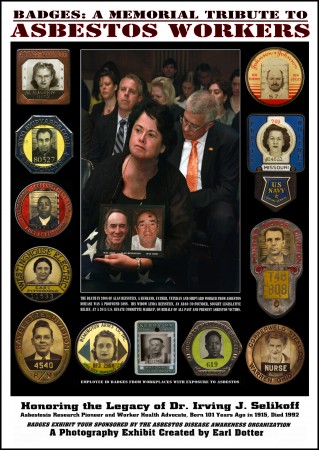
EARL: I am an avid collector of historical workplace photography and memorabilia that complements my own photographs of similar subjects. A few years ago I had a few Photo Employee ID Badges in my collection of workers with dangerous jobs but then noticed I could purchase others on Ebay. It was not long before I noticed many of the badges I had acquired came from industrial settings where asbestos was mined, manufactured or installed at construction sites of all kinds. A bell went off when I had lunch with Barry Castleman toward the end of 2014. In 1990 I had photographed Dr. Irving Selikoff working at the Mt. Sinai Medical Center as he presided at the Asbestos, The Third Wave Conference. Offhandedly I asked Barry when was Irving Selikoff’s birthday? Barry thought a moment and said, Irving was born in 1915, 100 years ago next year! Right then I said to Barry, I can create an asbestos related photo exhibit using my photo ID badges, historical material and my photographs. Then Barry called Phil Landrigan at Mt. Sinai and Linda Reinstein at the Asbestos Disease Awareness Organization proposing my exhibit idea to them. A short while later Linda called to encourage me to develop the BADGES exhibit for the next ADAO annual meeting in 2015.
LINDA: Please describe your exhibit panels.
EARL: The badges personalize the industrial victims of asbestos exposure. These badges appealed to me because personalizing my subjects who work in hazardous occupations has always been a primary goal for me. And what is unique about the badges is they name the companies that exposed the worker pictured on each badge. Quite naturally, it is easier to care about someone you are acquainted with. Viewers see a more personal side of this public health tragedy as a result. The panels make use of historical photographs and memorabilia that convey just how pervasive exposure to asbestos has been since the 1930’s and also point to important figures like Dr. Selikoff, Clarence Borel and Paul Brodeur who have taken active steps to draw attention to the harm from asbestos exposure and use.
LINDA: Where did your exhibit tour in 2015 and what did you accomplish?
EARL: Beginning at ADAO’s Annual Asbestos Awareness Conference in 2015 the BADGES exhibit almost immediately moved to the Washington, DC headquarters of the AFL-CIO in connection with Workers’ Memorial Day observations in April and May that year. From there BADGES went to the National Committee on Occupational Health and Safety Conference (NCOSH) in Baltimore; the 100th Anniversary Commemoration of Irving Selikoff’s Centennial in NYC at the Mt. Sinai Medical Center; the Harvard T.H Chan School of Public Health; and the New England College of Occupational and Environmental Health Conference in Boston to close out 2015. So far in 2016 the BADGES exhibit has appeared in NIOSH’s Alice Hamilton Building in Cincinnati and its Lab in Morgantown, WV and of course at the 2016 ADAO Conference.
I have been told by trade unionists, academics, students and survivors of asbestos disease that this exhibit vividly visualizes this tragic public health history from our past right up to the present time with unexplained new cases of asbestos disease claiming from 12,000 to 15,000 annually today. Students here in the U.S. and from around the world have been encouraged to look to their own countries use of asbestos today. Public health academics say to me the exhibit reveals that the asbestos story is sadly still unfolding with unfortunate new victims still emerging all over the world and in our own neighborhoods.
LINDA: Your BADGES: A Memorial Tribute to Asbestos Workers exhibit is expanding. Please tell our readers about your new panels and poster.
EARL: This year the BADGES exhibit more than doubled in size thanks to photographic contributions from ADAO Board Member, Tony Rich, an accomplished professional industrial hygienist, asbestos artifact collector and photographer. My outreach to author Paul Brodeur and to the descendants of Clarence Borel resulted in panels that visualize this investigative reporter’s importance and this asbestos insulator’s significant litigation and work history. Clarence’s son Bracy, also an insulator and Clarence’s other children also became victims of asbestos exposure. Mostly with the exhibit in 2017 I want to begin emphasizing the travail of current victims of asbestos disease and the resulting activism the ADAO fosters.
LINDA: How do you feel BADGES can help in legislative efforts to ban asbestos?
EARL: The ADAO membership can always use the visual resources of the exhibit in their outreach work with state and federal politicians. When ADAO has a press conference, portions of the BADGES exhibit can be the backdrop and digital files of BADGES exhibit images can be used by reporters to help illustrate the reason behind ADAO political initiatives.
LINDA: What do you have or hope to accomplish?
EARL: I believe with any movement, the individuals within it, offer particular and complementary skill sets. Mine happens to be making personalized photographs that show how vital each individual contribution from ADAO supporters are to make a total and complete ban of asbestos use in the USA happen…
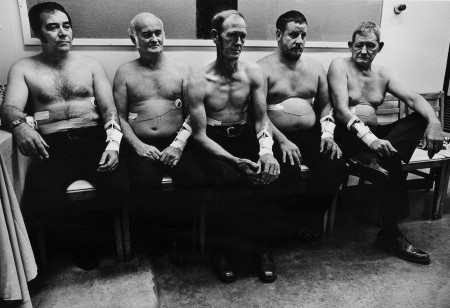
LINDA: How can the Asbestos Disease Awareness Organization community help you?
EARL: This past year I received support to photograph the Borel Family and Paul Brodeur where they live. This strengthened what I do and also the bond the Borel Family and Paul Brodeur share with ADAO now. Similar support in the future that enables me to travel to sites where asbestos disease sufferers are living and where key activism is occurring toward a total asbestos ban, will help make the BADGES exhibit a telling ongoing chronicle of its vital work.
***
Earl, we can’t thank you enough for your tireless dedication to raising asbestos awareness, documenting workplace hazards, and supporting ADAO.
Linda

